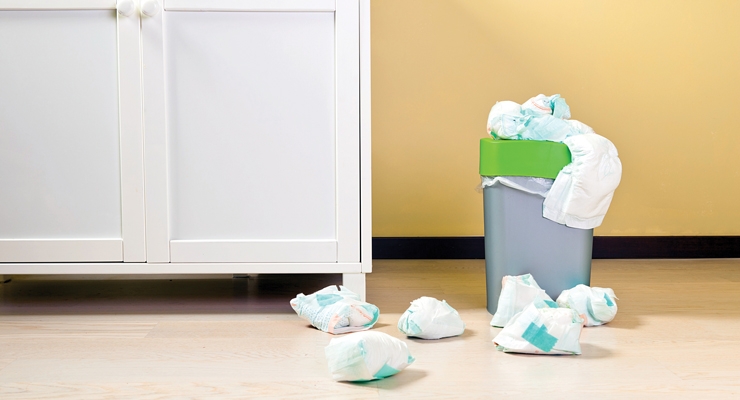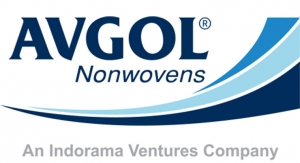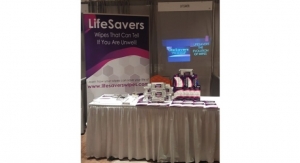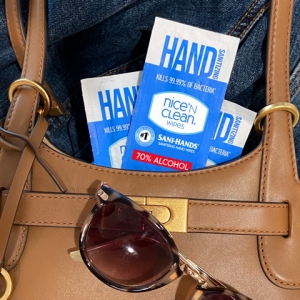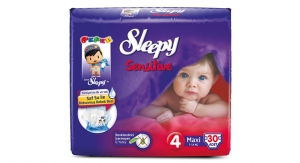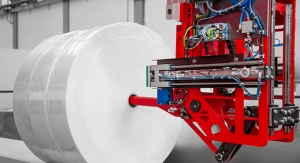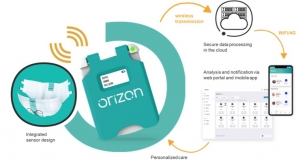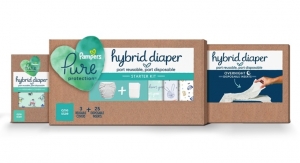Karen McIntyre, Editor01.05.18
Keeping fewer diapers, or diaper material, out of landfills. This has been the challenge facing the industry since the beginning. As other types of household waste like plastic bottles, paper and glass have made their way to recycling bins, diapers continue, in most cases, to end up in the landfill, representing as much as 5-10% of waste in some countries.
Looking to reduce this percentage, efforts to find a better end-of-life solution for diapers are underway around the world. Procter & Gamble has launched pilot recycling initiatives in Italy and the Netherlands; Unicharm is collecting diapers for recycling in a small city in Japan and Kimberly-Clark has been helping compost diapers in New Zealand.
These efforts are small in scale, for now, but they are blazing a trail for what can be achieved in the future.
“I believe that diaper recycling in a large mass scale, at least in mature economies, will be a reality within the next 10 years, probably years ahead before a man reaches Mars,” says Carlos Richer, founder of the Disposable Diaper Network, an industry consultancy. “The real issue, more than which technology is the final winner for the most efficient recycling, is making it easier for the consumer to dispose of the diapers without the need of a special stream.”
A community Wales has been working on just such a formula in recent months. Bridgent County, along with its waste partner Kier, introduced a “purple bag” over the summer for absorbent waste collection. Since this launch, 7720 families have signed up for this collection, and this number is growing by 100 families per week. The diapers’ cellulose fibers are removed from the waste and then used to make fiber board and acoustic paneling while the remaining plastic is sent for further processing.
According to officials, the program has already kept 278 tons of absorbent products out of landfills and the percentage of household waste that is recycled in the county has increased from 57% to 74%.
Japanese diaper manufacturer Unicharm has been involved in a pilot recycling program in Shibushi City, Kagaoshima Prefecture, Japan, since November 2016. Shibushi City was chosen as a partner because it has made significant advances in recycling efforts, reducing its landfill waste by 80% between 1998-2015. Of the remaining landfill waste in the city, 20% of it is disposable baby diapers, but program faciliatators hope to bring that percentage down. The pilot program reportedly uses Unicharm’s own recycling technology, which is a unique ozonation process that cuts diaper waste with old paper, separates it and uses it to make granules of papers sand, which is then used as a deodorizing kitty litter.
Unicharm sees its efforts in Shibushi City as a framework that could ultimately expand nationally or even globally. Elsewhere, Unicharm is about to begin operating a large-scale factor waste diaper recycling system at its Diana subsidiary in Vietnam. The system, which is being supplied by Diaper Recycling Technology from Singapore uses low levels of energy to recycle factory diaper waste. The newly developed technology converts the factory waste back into their original raw material formats in an cost effective way using just 15KW to operate. “The new low energy vertical orientated process requires minimal floor space and man-power to operate and can achieve up to an 87% financial recovery rate after all operating costs are paid. This means for every $1000 going into the machine up to $870 can be recovered,” explains CTO Martin Scaife . “The low operating costs translates into a quick return on investment which typically ranges from 12-15 months.“
The technology processes the plastic stream over 400 times achieving a excellent purity that facilities the direct conversion into a PE/PP pellet mix allowing the reuse of the plastic stream in many other industries. The SAP is removed without the need to pass it through buster or air transport fans, meaning it can be recovered without compromising its overall quality.
“We had a number of customers contacting us from the developing markets. Many of these customers have small factories with only one or two convertors,” he says. “Investing in a high capacity recycling system was not cost effective so a lot of them were burning their waste. When the magnitude of this problem was understood we redeployed one-third of our R&D and engineering teams to re-scale the original process into small systems.”
Diaper Recycling Technology is rapidly expanding their supply chain to cope with customer demand and now offers their latest generation of technology in a number of production levels—zero to 50 kg/h;50-110 kg/h; 100-200 kg/h and 200-400 kg/h to meet the needs of many customers globally.
Richer agrees that coming up with a viable plan to recycle diapers is a more attractive lifecycle solution than developing a biodegradable diaper or incinerating diaper waste. The recyclable content of the diaper is comprised almost equally of plastics, superabsorbent material and fluff pulp.
“There are several diaper recycling technologies being proposed, most of them are already better solutions than proposing the use of a biodegradable diaper. You need time and energy to produce a biodegradable diaper, to have it reach its end of life converted into CO2 and CH4 for sure is not an ecological solution,” he adds.
Osprey has been creating absorbent products recycling systems since the early 1980s and is said to have more than 60 systems in operation around the world. “One of our customers—a major multinational diaper producer—has used regional recycling hubs globally to leverage recycling to meet their needs,” says Rick Klaus, technical sales manager. “We have also had some independent recyclers that have benefited using our methodology and systems to process materials on an independent basis.”
According to Klaus, a hygiene operation needs to have five or six diaper lines to justify the expense of the recycling system and the fluff and SAP recovered from the materials are only acceptable for use in second tier products like underpads, pet pads and pet diapers while the nonwovens cannot be reused unless it has gone through an additional super cleaning process where it is size reduced and filters to remove remaining fluff, SAP and other materials.
Dutch Treat
In June, Procter & Gamble announced it had partnered with AEB Amsterdam to launch a diaper recycling program, similar to one already underway in Italy through P&G subsidiary Fater. The operation should be fully operational sometime this year, giving new life to about 10,000 tons of disposable diaper material annually.
According to Ioannis Hatzopoulos, who manages global baby care sustainability communications at P&G, interest in recyclability is high in the Netherlands for several reasons. There is limited landfill space; high level ground water increases risk of contamination; and there are limited natural resources. The goal of the recycling project is to find new life for the materials sourced from recycled diapers while limiting the industry’s toll on landfill space and the environment in general.
Hatzopoulos says that increasing the recyclability of its diapers is part of P&G’s four-point sustainability vision which includes powering its plants solely through renewable power, using 100% recycled materials, conserving resources and contributing to zero landfill waste. The limited life span of disposable diapers and their impact on the environment has been a source of negativity since these products first became available several decades ago.
“The percentage that diapers contribute to household waste is growing—it’s now between 5-10%—and it’s a very visible part of household waste that is not recycled,” he adds. “Our customers have been plaguing us to do something about disposable products.”
P&G has been involved in diaper recycling in Italy since 2015 through Fater, its joint venture company with Gruppo Angelini. In August, Fater replaced its pilot scale recycling operation with an industrial scale operation. Like the one planned for Amsterdam, the new operation can recycle 10,000 tons of absorbent hygiene products per year, affecting roughly one million people.
According to Hatzopoulos, the recycling process removes human waste from the product and then separates the diaper material into three waste streams—supersabsorbent materials, mixed plastics and pulp. These materials then find life in new applications and create a new revenue stream for the company.
Local authorities in Amsterdam are subsidizing the recycling operation, hoping to ease the diaper industry’s strain on the environment. Much waste, including diapers, is incinerated in The Netherlands but recycling is a better option because it lessons greenhouse gas emissions and gives a new life to the recycled materials.
Klaus says P&G’s decision to start a pilot program in The Netherlands was not surprising because the country is highly motivated to find a recycling solution and most end users would respond well to a recycling effort if regional programs and logistics for collection were put in place.
“The key to post-consumer waste recycling being financially viable is a steady source of waste to offset the operating costs,” he says. “Therefore, particularly in the North American market, regional mandatory compliance measures will need to be enacted along with the logistics of collection developed before we see widespread post-consumer waste recycling.”
Looking to reduce this percentage, efforts to find a better end-of-life solution for diapers are underway around the world. Procter & Gamble has launched pilot recycling initiatives in Italy and the Netherlands; Unicharm is collecting diapers for recycling in a small city in Japan and Kimberly-Clark has been helping compost diapers in New Zealand.
These efforts are small in scale, for now, but they are blazing a trail for what can be achieved in the future.
“I believe that diaper recycling in a large mass scale, at least in mature economies, will be a reality within the next 10 years, probably years ahead before a man reaches Mars,” says Carlos Richer, founder of the Disposable Diaper Network, an industry consultancy. “The real issue, more than which technology is the final winner for the most efficient recycling, is making it easier for the consumer to dispose of the diapers without the need of a special stream.”
A community Wales has been working on just such a formula in recent months. Bridgent County, along with its waste partner Kier, introduced a “purple bag” over the summer for absorbent waste collection. Since this launch, 7720 families have signed up for this collection, and this number is growing by 100 families per week. The diapers’ cellulose fibers are removed from the waste and then used to make fiber board and acoustic paneling while the remaining plastic is sent for further processing.
According to officials, the program has already kept 278 tons of absorbent products out of landfills and the percentage of household waste that is recycled in the county has increased from 57% to 74%.
Japanese diaper manufacturer Unicharm has been involved in a pilot recycling program in Shibushi City, Kagaoshima Prefecture, Japan, since November 2016. Shibushi City was chosen as a partner because it has made significant advances in recycling efforts, reducing its landfill waste by 80% between 1998-2015. Of the remaining landfill waste in the city, 20% of it is disposable baby diapers, but program faciliatators hope to bring that percentage down. The pilot program reportedly uses Unicharm’s own recycling technology, which is a unique ozonation process that cuts diaper waste with old paper, separates it and uses it to make granules of papers sand, which is then used as a deodorizing kitty litter.
Unicharm sees its efforts in Shibushi City as a framework that could ultimately expand nationally or even globally. Elsewhere, Unicharm is about to begin operating a large-scale factor waste diaper recycling system at its Diana subsidiary in Vietnam. The system, which is being supplied by Diaper Recycling Technology from Singapore uses low levels of energy to recycle factory diaper waste. The newly developed technology converts the factory waste back into their original raw material formats in an cost effective way using just 15KW to operate. “The new low energy vertical orientated process requires minimal floor space and man-power to operate and can achieve up to an 87% financial recovery rate after all operating costs are paid. This means for every $1000 going into the machine up to $870 can be recovered,” explains CTO Martin Scaife . “The low operating costs translates into a quick return on investment which typically ranges from 12-15 months.“
The technology processes the plastic stream over 400 times achieving a excellent purity that facilities the direct conversion into a PE/PP pellet mix allowing the reuse of the plastic stream in many other industries. The SAP is removed without the need to pass it through buster or air transport fans, meaning it can be recovered without compromising its overall quality.
“We had a number of customers contacting us from the developing markets. Many of these customers have small factories with only one or two convertors,” he says. “Investing in a high capacity recycling system was not cost effective so a lot of them were burning their waste. When the magnitude of this problem was understood we redeployed one-third of our R&D and engineering teams to re-scale the original process into small systems.”
Diaper Recycling Technology is rapidly expanding their supply chain to cope with customer demand and now offers their latest generation of technology in a number of production levels—zero to 50 kg/h;50-110 kg/h; 100-200 kg/h and 200-400 kg/h to meet the needs of many customers globally.
Richer agrees that coming up with a viable plan to recycle diapers is a more attractive lifecycle solution than developing a biodegradable diaper or incinerating diaper waste. The recyclable content of the diaper is comprised almost equally of plastics, superabsorbent material and fluff pulp.
“There are several diaper recycling technologies being proposed, most of them are already better solutions than proposing the use of a biodegradable diaper. You need time and energy to produce a biodegradable diaper, to have it reach its end of life converted into CO2 and CH4 for sure is not an ecological solution,” he adds.
Osprey has been creating absorbent products recycling systems since the early 1980s and is said to have more than 60 systems in operation around the world. “One of our customers—a major multinational diaper producer—has used regional recycling hubs globally to leverage recycling to meet their needs,” says Rick Klaus, technical sales manager. “We have also had some independent recyclers that have benefited using our methodology and systems to process materials on an independent basis.”
According to Klaus, a hygiene operation needs to have five or six diaper lines to justify the expense of the recycling system and the fluff and SAP recovered from the materials are only acceptable for use in second tier products like underpads, pet pads and pet diapers while the nonwovens cannot be reused unless it has gone through an additional super cleaning process where it is size reduced and filters to remove remaining fluff, SAP and other materials.
Dutch Treat
In June, Procter & Gamble announced it had partnered with AEB Amsterdam to launch a diaper recycling program, similar to one already underway in Italy through P&G subsidiary Fater. The operation should be fully operational sometime this year, giving new life to about 10,000 tons of disposable diaper material annually.
According to Ioannis Hatzopoulos, who manages global baby care sustainability communications at P&G, interest in recyclability is high in the Netherlands for several reasons. There is limited landfill space; high level ground water increases risk of contamination; and there are limited natural resources. The goal of the recycling project is to find new life for the materials sourced from recycled diapers while limiting the industry’s toll on landfill space and the environment in general.
Hatzopoulos says that increasing the recyclability of its diapers is part of P&G’s four-point sustainability vision which includes powering its plants solely through renewable power, using 100% recycled materials, conserving resources and contributing to zero landfill waste. The limited life span of disposable diapers and their impact on the environment has been a source of negativity since these products first became available several decades ago.
“The percentage that diapers contribute to household waste is growing—it’s now between 5-10%—and it’s a very visible part of household waste that is not recycled,” he adds. “Our customers have been plaguing us to do something about disposable products.”
P&G has been involved in diaper recycling in Italy since 2015 through Fater, its joint venture company with Gruppo Angelini. In August, Fater replaced its pilot scale recycling operation with an industrial scale operation. Like the one planned for Amsterdam, the new operation can recycle 10,000 tons of absorbent hygiene products per year, affecting roughly one million people.
According to Hatzopoulos, the recycling process removes human waste from the product and then separates the diaper material into three waste streams—supersabsorbent materials, mixed plastics and pulp. These materials then find life in new applications and create a new revenue stream for the company.
Local authorities in Amsterdam are subsidizing the recycling operation, hoping to ease the diaper industry’s strain on the environment. Much waste, including diapers, is incinerated in The Netherlands but recycling is a better option because it lessons greenhouse gas emissions and gives a new life to the recycled materials.
Klaus says P&G’s decision to start a pilot program in The Netherlands was not surprising because the country is highly motivated to find a recycling solution and most end users would respond well to a recycling effort if regional programs and logistics for collection were put in place.
“The key to post-consumer waste recycling being financially viable is a steady source of waste to offset the operating costs,” he says. “Therefore, particularly in the North American market, regional mandatory compliance measures will need to be enacted along with the logistics of collection developed before we see widespread post-consumer waste recycling.”

